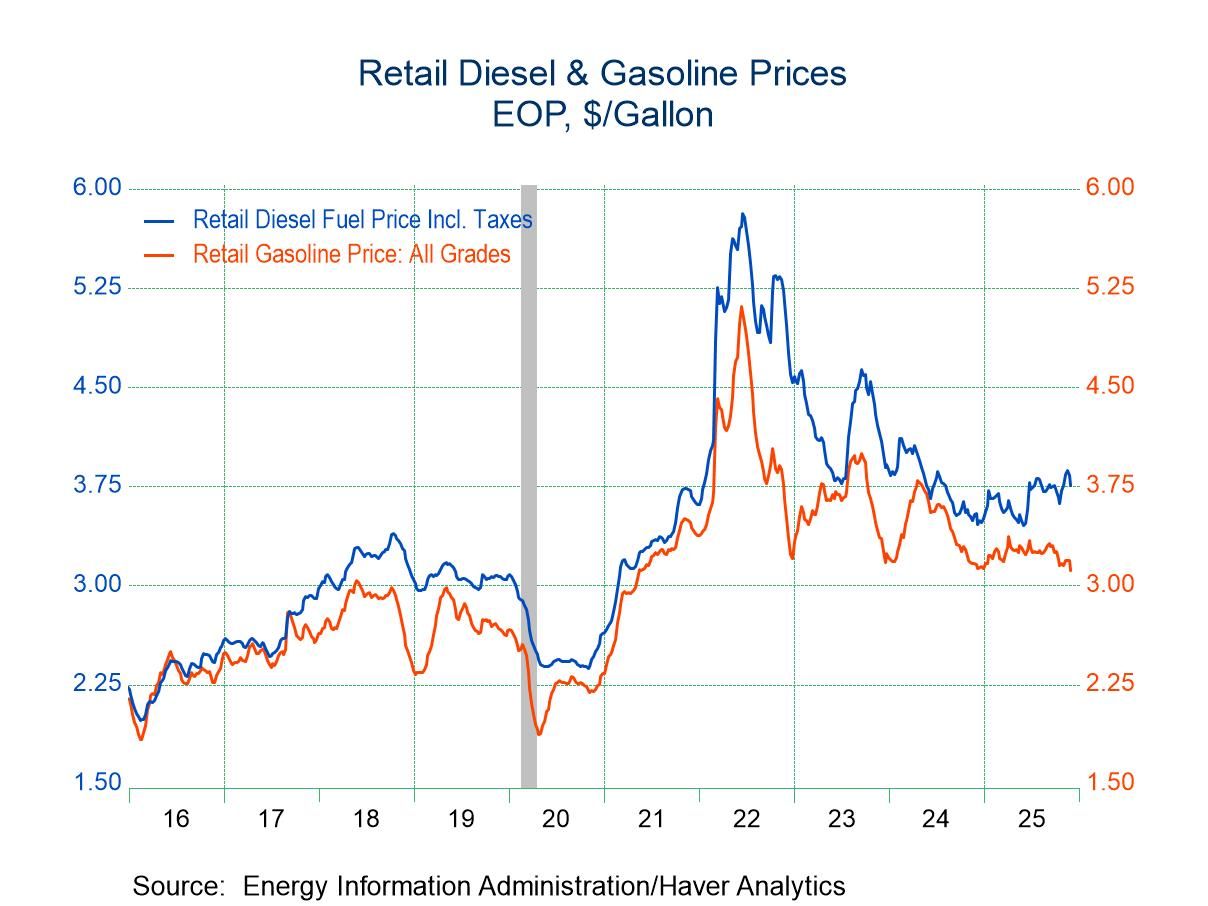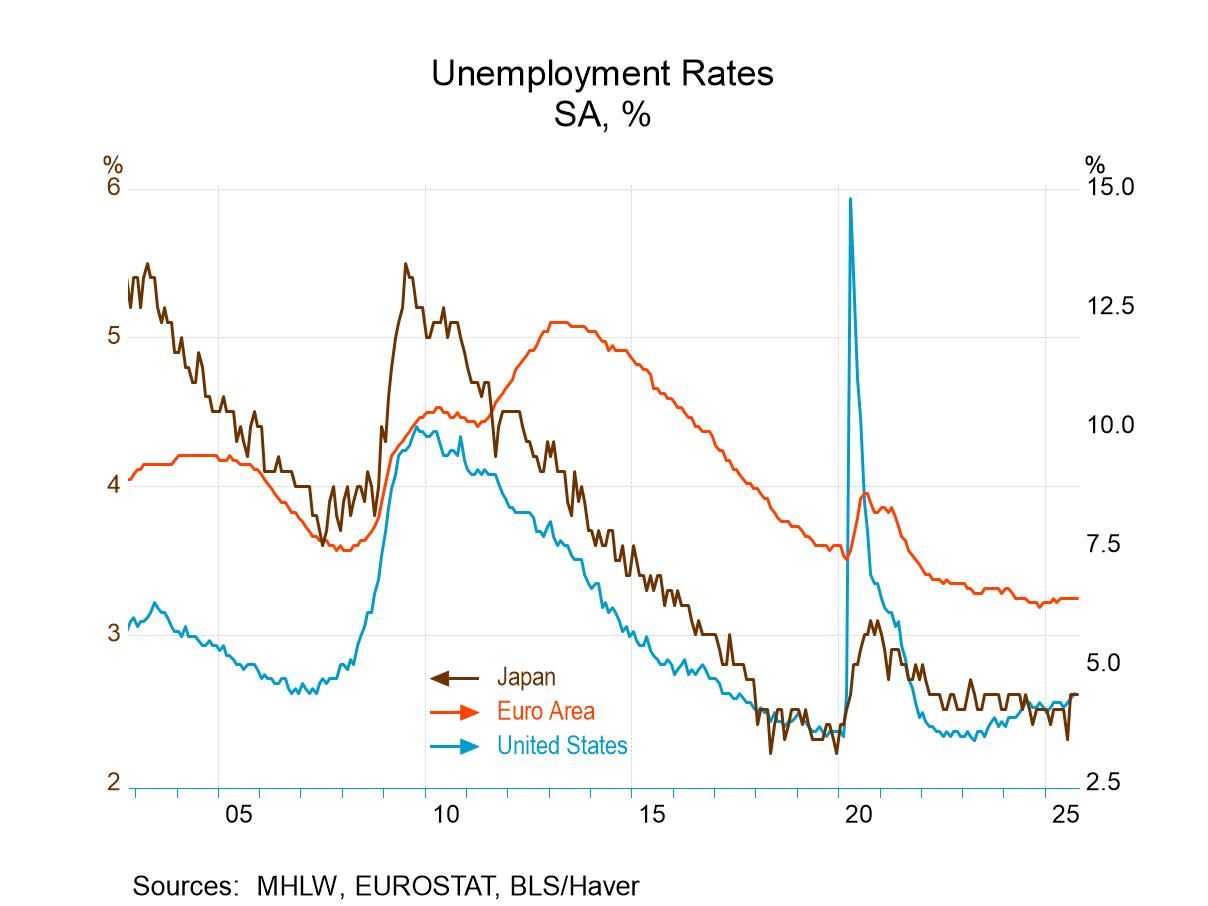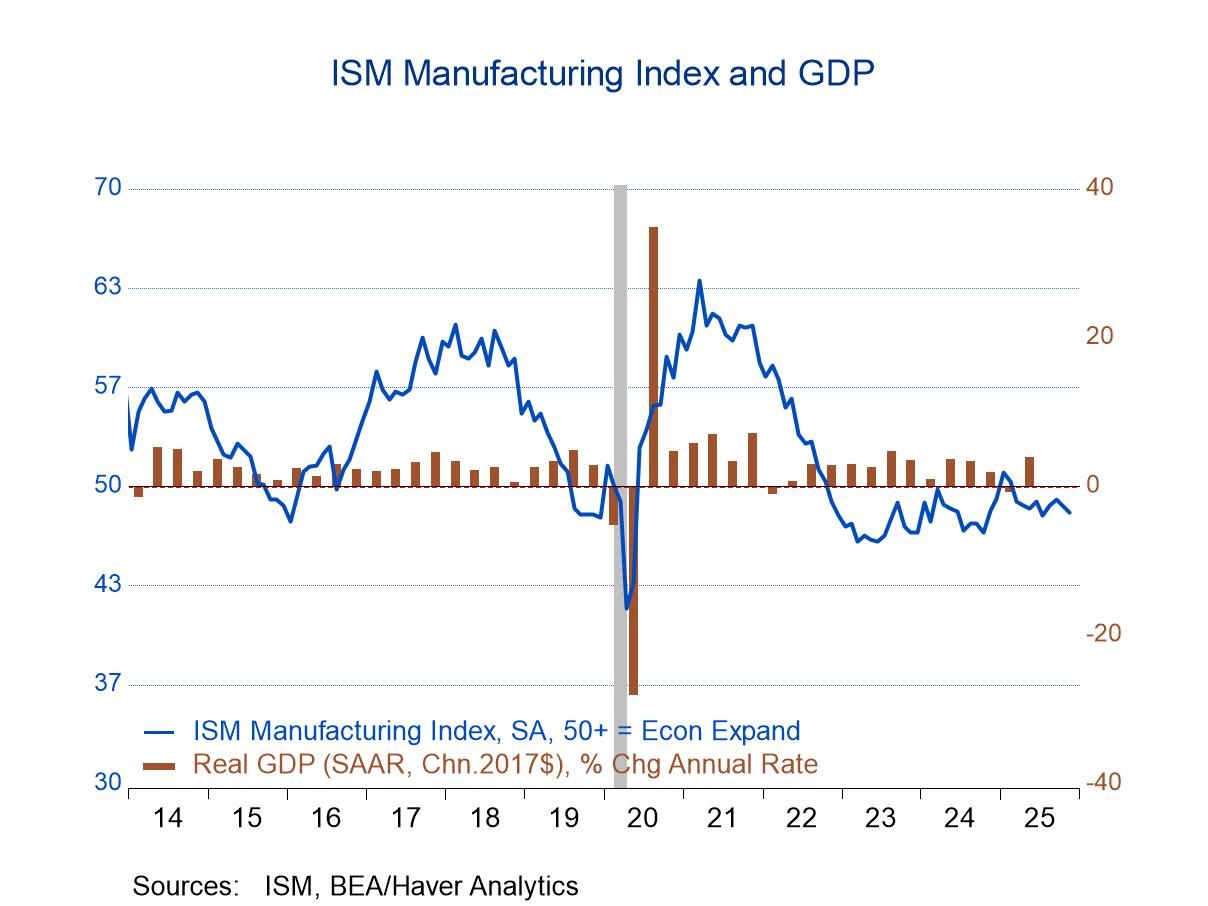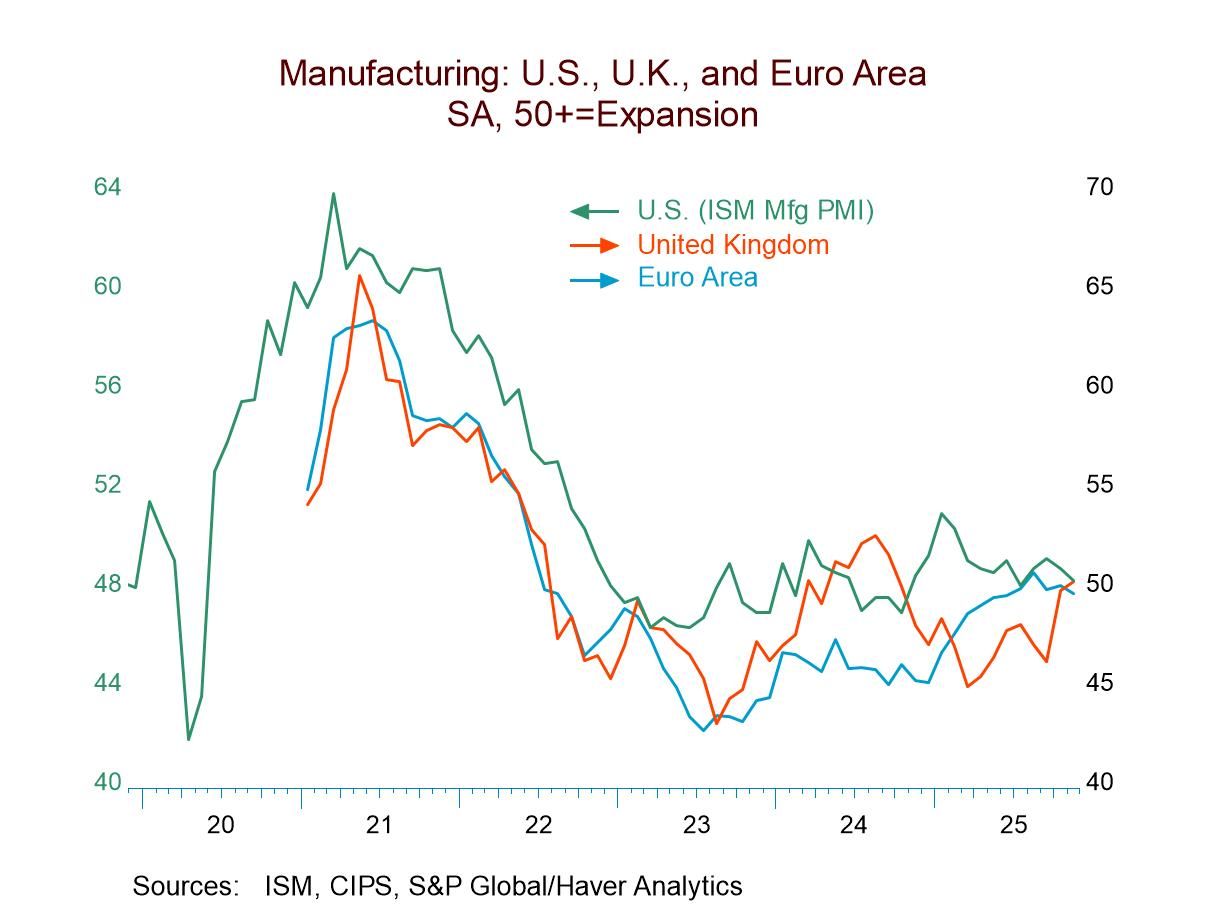 Global| Jun 30 2025
Global| Jun 30 2025Globally Money Growth Stabilizes Except in Japan

Globally money growth has stabilized more in the month of May.
In the European Monetary Union (EMU) over three months the annualized money growth rate ticked up to 2.9%, compared with 2.5% growth rate over six months and a 3.6% growth rate over 12 months; over two and three years the growth rate for money in EMU has been 2% for two years and 1.4% for three years. Compared to that, we have money growth sustaining itself at a stronger level.
In the United States, money growth continues to accelerate but slightly; the three-month growth rate for money is 6.2%; at an annual rate over six months it's 4.9%; over 12 months its pace is 4.5%. Money growth has steadily accelerated compared to a 0.4% growth over 3 years and a 2.7% pace over 2 years. The U.S. is the one exception where money growth rates are looking hot and where there has been steady acceleration in these growth rate; these calculations are in terms of M2.
The United Kingdom shows more variability as 12-month growth in U.K. for the money aggregate M4 is 3.5%. That moves up to 4.1% over 6 months and is back down to 1.7% annualized over 3 months. So, the 3-month growth rate in the U.K. is looking more like the 1.8% growth rate over 2 years, but even that stepped up from 1.1% over 3 years. In the case of the U.K., money growth rates have picked up and do seem to have steadied and they are off their top growth pace. However, at 1.7% the nominal growth rate of money over three months is on the light side
Japan, of course, is the central bank that is still engaged in raising rates and still has an acknowledged inflation problem. In Japan, the 3-month growth rate for M2 plus CDs is -1.3% annualized, weaker than 0.1% over 6 months which is weaker than 0.6% over 12 months; the Japanese money growth rates also decelerate from three-years to two-years and continue to decelerate on down to three-months. The Bank of Japan is still plotting its strategy for an inflation rate that appears to be both stubborn and slightly excessive. However, it's a welcome set of problems compared to the deflation that Japan dealt with the decade earlier.
Real money balances Real money balances tend to show some step up in pace. In the case of the European Monetary Union, there's a steady acceleration of money growth from -2% at an annual rate over three years to +2.3% over 3 months and more or less steady pickups from period to period in between.
In the U.S., real money growth rates show a persistence acceleration from -2.8% at an annual rate over three years to the 5.2% annual rate over three months. Real money supply growth in the U.S. is cooking and strong, particularly over three months. However, over six months the growth rate is only 2.2% so the heat in terms of U.S. money supply growth is a relatively recent phenomenon.
In the U.K., real M4 growth continues to show contraction and M4 growth contracts over all horizons; over three years, two years 12 months, six months and three-months. However, the three-month contraction is at a -1.6% rate, deeper contraction than the 12-month rate (-0.4%) and pretty close to what it's done over two years on balance (-1.5%) although that's a step up in the pace of contraction compared to 12-months to six-months. U.K. growth has been running on the weak side in addition to its weak real and nominal money supply growth.
Japan shows contraction and money supply overall horizons and the contraction gets progressively larger over more recent periods; money growth is at a -4.1% annual rate over three months and that compares to -2.8% over 12 months, logging a declining rate of -1.4% at an annual rate over three years. Japan’s weak real money growth is a policy decision.
The background for real and nominal money growth is that oil prices are continuing to fall. They're falling in nominal terms and in real terms with year-over-year oil prices falling at about a 23% annual rate and in real terms the oil price is falling at about a 25% annual rate. The weakness in oil is helping central banks catch up on their inflation mandates at least four headline inflation.
EU credit growth is lax And the European Monetary Union credit growth continues to expand but it is slowing. Private credit grows 2.4% at an annual rate over 12 months, but that slips to 1.5% annualized over three months and compares to the kind of growth that Europe had been seeing over two and three years where the growth rates averaged 1.4% and 1.7%. Real credit growth in the monetary union shows that there has been a pickup in the growth rates from 12 months to six months to three months; all show expansion although there's not steady acceleration there is steady positive growth. Those are good developments for the outlook for growth.

Global conditions Global inflation rates have begun to coalesce a little bit more around a 2% pace. Tariffs continue to be a sticking point as they haven't been sorted out yet and the U.S. and China continue to go back and forth while the U.S. and Canada appeared to have hit some sort of stalemate. Still, global geopolitics don't look quite as grim as they did a while ago. NATO has sided with the U.S. demand for them to spend more. More NATO countries have generally decided to spend 5% of GDP on military. In the Middle East, the attack on Iran's nuclear facilities has resulted in a ceasefire and a cooling off of the Iran-Israeli conflict although we can't report any such cooling that is extended to Ukraine-Russia. The global geopolitical situation remains touch and go, but the fact that NATO countries were able to cut a deal is good news; having a ceasefire between Israel and Iran is good news; and we're waiting to see if we can report any kind of news on the tariff front as deadlines approach.
Money seems a less active force Money growth on its own has become more of a neutral factor with money generally not signaling growth that's too hot or too cold although with some very particular country level differences and especially with Japan continuing to try to reduce its domestic inflation rate. The main fly-in-the-ointment right now is excessive U.S. money growth. That's occurring while some U.S. statistics have been a little more touch and go and where the Federal Reserve is pursuing a wait-andsee attitude on future policy, but with the central bank still planning to tip the balance on the side of easing further.
Robert Brusca
AuthorMore in Author Profile »Robert A. Brusca is Chief Economist of Fact and Opinion Economics, a consulting firm he founded in Manhattan. He has been an economist on Wall Street for over 25 years. He has visited central banking and large institutional clients in over 30 countries in his career as an economist. Mr. Brusca was a Divisional Research Chief at the Federal Reserve Bank of NY (Chief of the International Financial markets Division), a Fed Watcher at Irving Trust and Chief Economist at Nikko Securities International. He is widely quoted and appears in various media. Mr. Brusca holds an MA and Ph.D. in economics from Michigan State University and a BA in Economics from the University of Michigan. His research pursues his strong interests in non aligned policy economics as well as international economics. FAO Economics’ research targets investors to assist them in making better investment decisions in stocks, bonds and in a variety of international assets. The company does not manage money and has no conflicts in giving economic advice.






